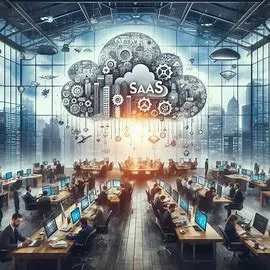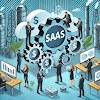Introduction
In today's rapidly evolving digital landscape, understanding Software as a Service (SaaS) is crucial for entrepreneurs and businesses aiming to leverage technology for growth and efficiency. This guide explores the essentials of SaaS, its benefits, examples, and its future in the business world.
I. What is SaaS?
A. Definition of SaaS (Software as a Service)
Software as a Service, or SaaS, is a model where software is delivered and accessed online rather than through traditional on-premise installations. Users subscribe to the service on a monthly or annual basis instead of purchasing the software outright. This approach offers numerous advantages such as easier updates, scalability, and lower upfront costs.
B. Importance of Understanding SaaS for Entrepreneurs and Businesses
For modern businesses, SaaS offers a transformative opportunity. By utilizing SaaS, companies can significantly reduce IT expenses, improve accessibility, enhance collaboration, and streamline operations. The agility provided by SaaS platforms enables businesses to adapt quickly to market changes and customer needs.
II. SaaS in the Cloud Computing Ecosystem
A. Explanation of SaaS as a Software Distribution Model
SaaS is a distribution model that delivers software applications over the internet. These applications are hosted and maintained by a third-party vendor, which eliminates the need for organizations to handle installation, maintenance, or management of the software. This allows businesses to focus on their core operations.
B. Comparison with Other Cloud Computing Categories (IaaS, PaaS)
SaaS differs from Infrastructure as a Service (IaaS) and Platform as a Service (PaaS). SaaS provides a complete software solution purchased on a pay-as-you-go basis from a cloud service provider. In contrast, IaaS offers virtualized computing resources over the internet, and PaaS provides a platform allowing customers to develop, run, and manage applications without dealing with the infrastructure typically required. SaaS allows rapid deployment with minimal upfront costs.
III. Examples of SaaS
A. Popular SaaS Examples (Salesforce, Slack, Dropbox, Zoom)
Popular SaaS applications have become integral to modern business operations. Examples include:
- Salesforce: Offers customer relationship management solutions.
- Slack: A hub for team collaboration.
- Dropbox: Known for file sharing and storage.
- Zoom: A leader in video communications.
Each of these applications enhances productivity and connectivity across various industries.
B. Understanding Netflix as a SaaS Company
While Netflix is primarily seen as a streaming service, it fits into the SaaS category due to its subscription-based model and reliance on cloud services to deliver content. This model highlights the broad applicability of SaaS beyond typical business software.
IV. How SaaS Works
A. Cloud Delivery Model in SaaS
SaaS operates under a cloud delivery model where applications are hosted on remote servers and provided to users over the internet, enabling rapid deployment, global accessibility, and dynamic scaling according to business needs.
B. Hosting Applications and Data
In a SaaS setup, the software provider hosts the application and associated data on their servers, databases, and networking resources. Clients access the software via the internet without worrying about the underlying infrastructure.
C. Accessibility Across Devices
SaaS applications can be accessed through desktop computers, tablets, and smartphones, making them highly versatile and convenient for users on the go.
V. Growth and Future of SaaS
A. Market Predictions for SaaS Products
Experts predict robust growth in the SaaS sector, driven by the increasing adoption of cloud services across all business domains. This growth is supported by rising demand for AI and machine learning integrations within SaaS solutions.
B. Expected Market Size by 2024
The market size of SaaS is expected to expand significantly, with experts projecting continued growth as more enterprises transition from traditional software models to cloud-based solutions.
Conclusion
Understanding and implementing SaaS can provide substantial benefits for businesses, including cost savings, improved accessibility, and enhanced operational efficiency. As the market continues to grow and evolve, SaaS will remain a pivotal element in the digital strategies of modern enterprises.





0 Comments